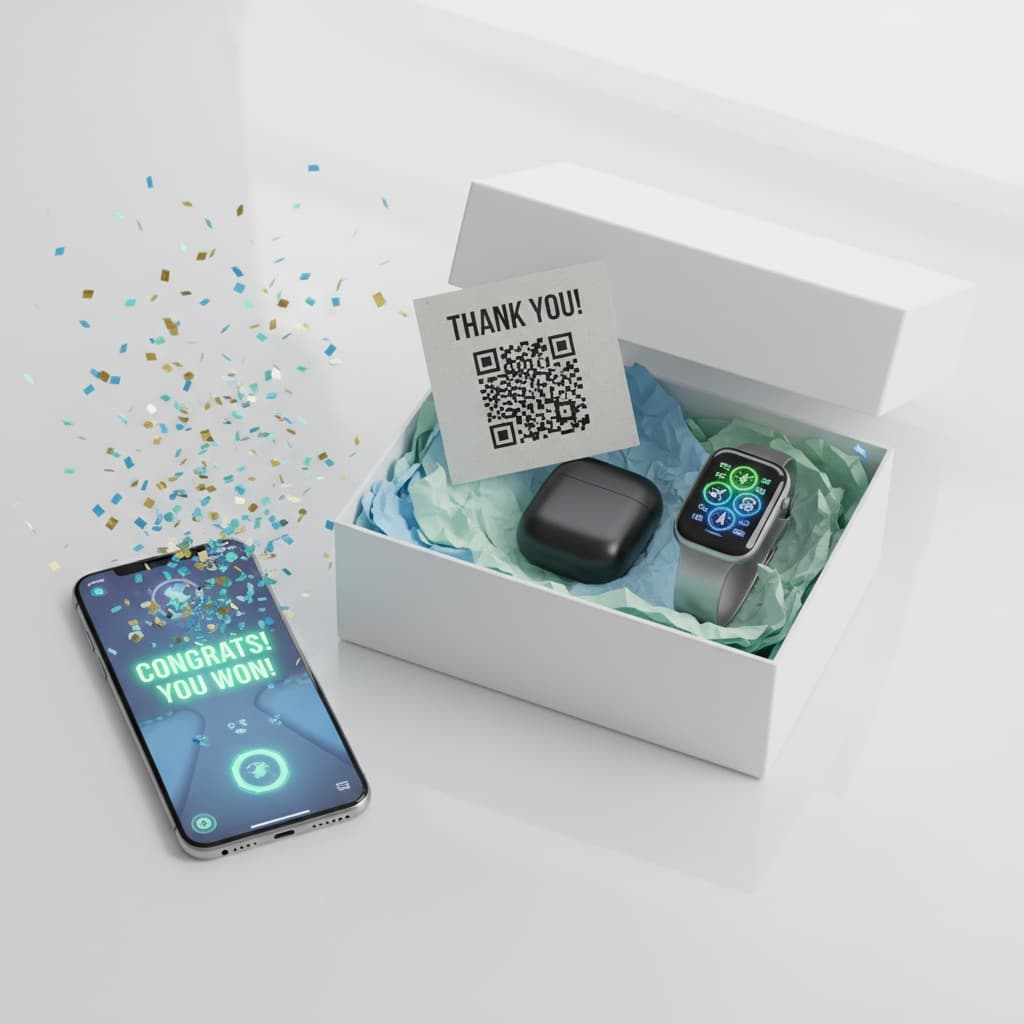QR codes have turned product packaging into one of the most powerful touchpoints in the customer journey. Instead of being a static container, the box, label, or sleeve becomes a digital bridge that can onboard customers, unlock rewards, teach usage, collect reviews, and trigger reorders. When used correctly, QR codes in product packaging increase retention, improve satisfaction, and generate measurable first party data.
This guide explains how to use QR codes in product packaging across the full lifecycle. You will see how to design onboarding flows, deliver personalized rewards, trigger loyalty actions, launch AR experiences, provide product education, collect reviews, send refill reminders, gamify unboxing, and capture customer data in a privacy friendly way. You will also learn how brands measure ROI from these interactions.
Turn your packaging into a digital engagement channel
Use QR codes, rewards, and smart flows to connect every box and label to an interactive experience your customers love.
Onboarding flows that start the relationship right
The first scan sets the tone for the entire relationship. When customers receive your product and see a clear QR code on the box, label, or insert, they should know exactly what they get by scanning. The landing experience must be fast, mobile first, and focused on helping them succeed with the product.
An effective onboarding flow includes a welcome message, simple setup instructions, a quick benefit summary, and one clear action such as create your profile, save your preferences, or unlock your first reward. Avoid sending customers to a generic homepage. Instead, design a dedicated onboarding screen that connects directly to the product in their hands.
Brands that use QR onboarding well often see lower support volume and higher repeat purchase rates. Customers feel guided, not left alone with a product and a small printed manual. With platforms like VISU retail engagement solutions, you can build dynamic onboarding pages where content changes by product, market, or campaign without reprinting packaging.

Personalized rewards and loyalty triggers
QR codes in packaging are perfect entry points for loyalty systems and rewards programs. When customers scan a code, you can identify the product, approximate the purchase date, and connect that event to a profile or session. This makes it easy to reward usage, not only purchases.
A simple pattern is scan to claim your points. The code leads to a page where customers confirm their email or phone number and instantly see a reward balance. You can also segment rewards by product line, store, or campaign. For example, limited edition packaging might grant higher rewards or unlock exclusive tiers.
Loyalty triggers can go beyond points. A scan might count toward a mission, push a customer to the next tier, or unlock a hidden benefit like extended warranty. When QR scans are connected to your broader loyalty and QR campaigns using tools like VISU QR Ads, every physical product becomes part of the digital game that keeps customers engaged.
AR experiences that bring products to life
Augmented reality experiences turn packaging into a canvas. A QR code can open an AR view that shows how to assemble a product, where to apply a cosmetic, how furniture fits into a room, or how ingredients were sourced. These experiences increase understanding and delight, especially for complex or premium products.
For example, a toy brand can let kids scan the box to see a 3D version of the toy in action. A beverage brand can reveal animations, stories about origin, or artist collaborations when the label is scanned. A home appliance brand can show AR overlays on the device itself to illustrate buttons and maintenance points.
AR experiences require more investment than simple landing pages, so they should focus on real value. Use them when visuals and interactivity truly improve understanding or emotional connection. Always make sure there is a fallback experience for devices that do not support AR, such as a video or interactive guide.
Product education that reduces churn and returns
Many returns and negative reviews come from misuse or misunderstandings. QR codes give you unlimited space to educate customers without overloading the packaging with text. A single scan can open a hub with tutorials, FAQs, troubleshooting, and recommended routines.
Education flows might include getting started videos, detailed ingredient or material explanations, ideal usage frequency, and tips for best results. For some categories, step by step routines work well. For example, skincare brands can show morning and night sequences using multiple products, while coffee brands can show brew guides for different methods.
Well designed education content improves satisfaction and reduces support tickets. It also creates opportunities for soft cross sell. Once customers understand how to use a product, you can suggest complementary items with contextual copy instead of hard selling from the start.

Review collection at the perfect moment
Reviews are more powerful when collected at the right time, after customers have tried the product but before they forget the experience. QR codes on packaging let you capture feedback when customers are engaged. A simple scan can open a streamlined review form with prefilled product details.
To encourage participation, offer small rewards such as loyalty points, entries in a monthly draw, or early access to new products. Make the form short and mobile friendly. Ask targeted questions that help improve products and messaging, such as what problem were you trying to solve and did this product meet your expectations.
Some brands place a separate QR code dedicated to reviews on the insert or inside the lid. Others reuse the main QR flow and offer review prompts as a second step after onboarding or education. In both cases, you gain high intent feedback and social proof that supports future buyers.
Refill reminders and reordering flows
For consumable products, QR codes in packaging are ideal for reorders and refill reminders. When customers scan the code after using a product for a while, they can see reorder options with one tap. You can also capture consent to send time based reminders aligned with expected consumption cycles.
A typical flow looks like this. At first scan, customers receive onboarding content and can choose to activate smart reminders. The system records product type and approximate start date. Near the expected replenishment time, customers receive an email, SMS, or push notification that links back to the same QR campaign or a personalized reorder page.
This approach combines physical context with digital convenience. Customers do not have to search for product names or navigate complex menus. The QR code on the packaging acts as a shortcut to reordering, which increases repeat purchase rates and reduces friction.
Unboxing gamification that surprises customers
Unboxing is a moment of high emotion. Gamified QR experiences can use this attention to create surprise and delight. Instead of a static thank you card, include a QR code that reveals a mystery reward, limited time challenge, or mission inside your broader loyalty system.
Examples include instant win experiences, collect them all campaigns, or hidden codes that unlock access to secret collections. A food brand might hide different QR codes inside each flavor that count toward a series. A fashion brand might include a QR code that reveals a look challenge and gives extra points for posting styled photos.
The key is to balance excitement with clarity. Explain clearly what the customer can gain and how it works. Keep the experience quick and mobile friendly. When done well, unboxing gamification increases engagement, user generated content, and brand affinity without relying only on discounts.

Customer data capture in a privacy friendly way
One of the biggest advantages of QR codes in product packaging is the ability to capture first party data in a consent based format. Customers voluntarily scan codes and choose to share contact details in exchange for rewards, content, or convenience. This is much more sustainable than third party tracking alone.
Design your flows to explain why you ask for data and what customers receive in return. For example, you might request email to save their onboarding progress, link products to a profile, or send refill reminders. You might request preferences to personalize recommendations and missions. Always give customers control over frequency and channels.
Platforms like VISU allow you to connect scan data, engagement events, and rewards into a unified profile that can sync with your CRM or marketing tools. This gives you a clear picture of how packaging interactions drive long term value, without relying on invasive tracking techniques.
How brands measure ROI from QR codes in packaging
To justify investment, you need clear ROI measurement. Because every QR code interaction can be tracked, brands can see exactly how many scans occur, which products generate the most engagement, and how those scans correlate with revenue.
Key metrics include scan rate per package, completion rate of onboarding flows, time on page for education content, review submission rate, opt in rate for loyalty, and repeat purchase rate for customers who scan versus those who do not. Over time, you can analyze cohorts to see whether scanned customers show higher lifetime value and lower churn.
Advanced implementations attribute specific campaigns to QR codes with dynamic routing. For example, codes printed on seasonal packaging might lead to different content and rewards than codes on core product lines, while still using the same underlying short link infrastructure. With solutions like VISU QR Ads, marketers can adjust offers and journeys without changing the physical codes, which makes it easier to test and optimize for ROI.
Transform your packaging into a measurable engagement channel
Use dynamic QR codes, rewards, and smart journeys to onboard customers, capture data, and drive repeat purchases from every product you ship.

